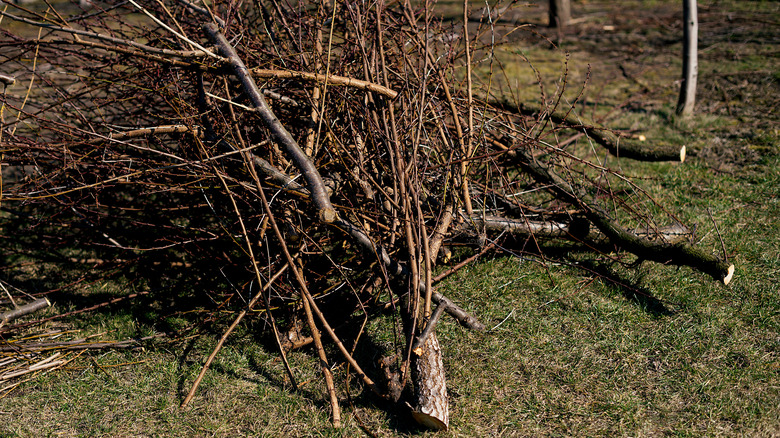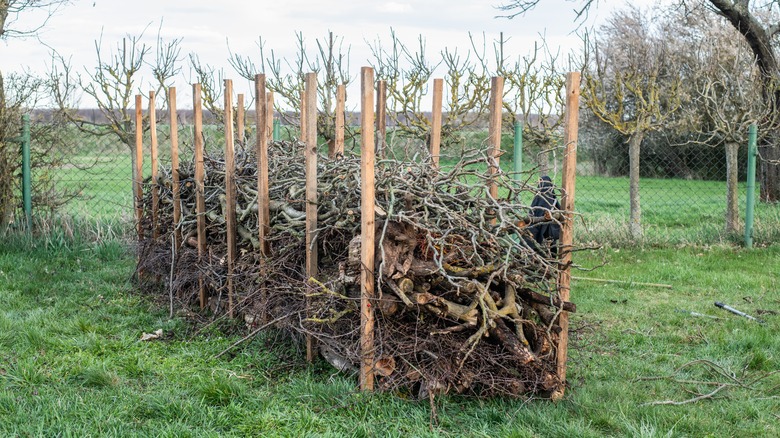Give Dead Branches New Life With This Trick From TikTok
It can certainly be frustrating if you've got dead branches in your yard or on the shrubs, trees, and bushes in your garden. If there is a lot of deadwood on your property, then you'll want to see the solution that the folks over at the @hastingscorner TikTok page have in mind: creating a dead hedge for all those errant twigs, branches, and sticks strewn across your lawn. A dead hedge is a structure that consists of vertical wooden or metal stakes, and piles of fallen branches and other yard debris placed in between them. The individual pieces of wood eventually interlock to create an especially dense and compact wall.
That structured space not only solves the problem of deadwood in your yard, but can also become a beneficial haven for songbirds like wrens and robins, as well as other wildlife. You can use a dead hedge as a natural decorative element, as well — marking different parts of your garden, as a fence, or as a border to mark the line of your property. If you want to start creating one in your yard with this gardening trick, all you'll need to get started are wooden posts, metal stakes, or bamboo poles and a few hours to collect as many dead or dying branches as you possibly can. Sure, you could leave the deadwood in your yard to attract woodpeckers, but a dead hedge could bring in even more birds.
How to create your own dead hedge
The ideal time to begin a dead hedge project is in the spring after winter's dead branches have given way, in the fall while there's lots of yard debris to collect, or just after a big storm has scattered branches and sticks all over your lawn, as was the case with the Hastings Corner Farm & Garden crew. They used tall bamboo poles intertwined with long, thin metal stakes, but you can use any sort of post as long as it's got enough height to contain all the dead branches.
Create a row of posts spaced between 2 and 3 feet apart, then build a parallel line of stakes about a foot away from this row to mirror it. Make the rows as long as you would like — you could start with one small dead hedge or create a large one as a structure intended to be a defining wall or fence. After that, you can begin to toss in every stick or twig on your property between the two lines. It's also a great way to get recycle the wood from those unwanted bushes that keep growing back.
To really get the most from this project, you'll need to have patience. Unless you have a ton of dead branches already, it won't look like much at first, especially if you're going for a more extensive dead hedge system. However, if you keep building it up week after week and month after month, you'll soon see a rustic outdoor structure come to life.
The benefits of having a dead hedge
Not only are dead hedges environmentally friendly because they're a way to reuse natural materials, but they're excellent places for birds, insects, chipmunks, and squirrels to make a home. Not only that, but if placed on a slope, they're a natural form of erosion control. If you're in the process of removing invasive plants from your garden, you can toss those into the pile as well. Once your dead hedge is full, consider beautifying it further by planting native, non-invasive vining plants around it, such as trumpet honeysuckle, cross vine, or American wisteria. Eventually, the dead branches will start to decompose, which will enrich the soil under and around the hedge structure.
If building a dead hedge is too much work for you, consider a brash pile instead — just a mound of sticks and twigs in your yard without the fuss of the stakes. This could be beneficial for amphibians, lizards, and small mammals. Otherwise, the dead pieces of wood can always be used as firewood or turned into mulch with a wood chipper. And you can bring the tree branches indoors to use as home decor while you're at it. Regardless of which option you choose, you'll be bringing a new lease on life to the decaying branches on your lawn.

